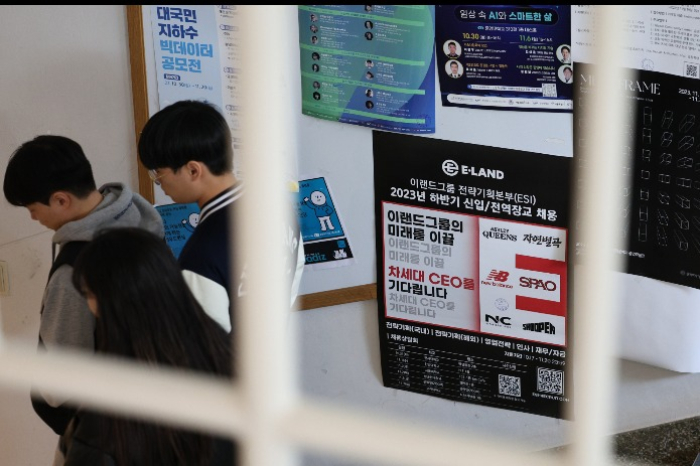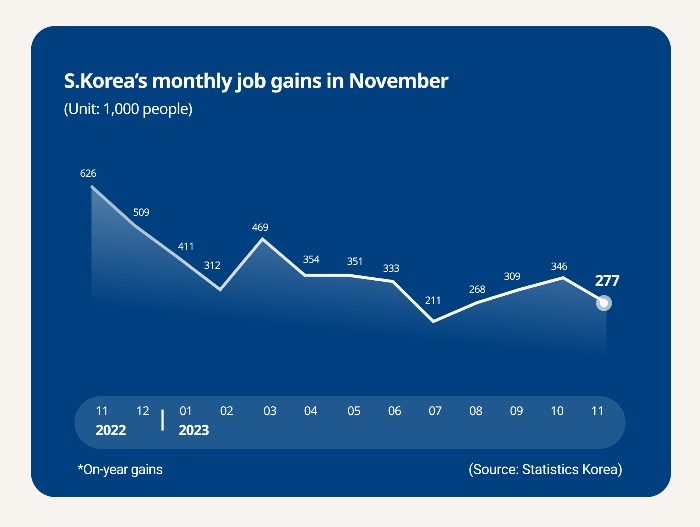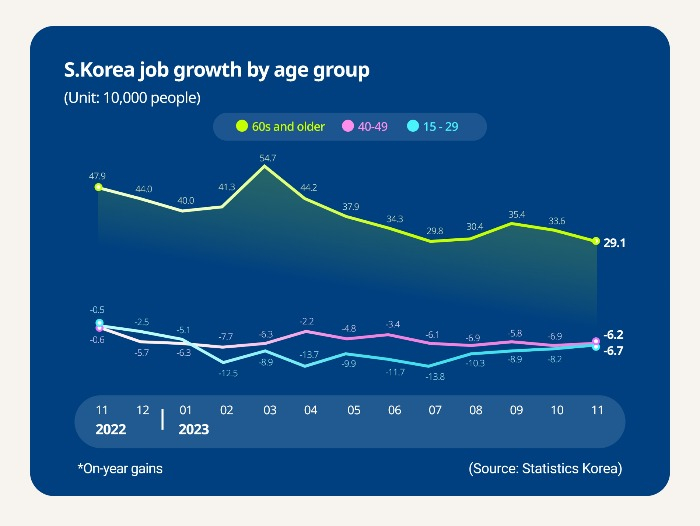Economy
S.KoreaŌĆÖs labor gains slow in November with fewer jobs for young people
AsiaŌĆÖs fourth-largest economy has shed jobs in the 15-29 age group for the 13th straight month
By Dec 13, 2023 (Gmt+09:00)
3
Min read
Most Read
S.Korea's LS Materials set to boost earnings ahead of IPO process


Hankook Tire buys $1 bn Hanon Systems stake from Hahn & Co.


Samsung Heavy Industries succeeds autonomous vessel navigation


Samsung shifts to emergency mode with 6-day work week for executives


NPS to hike risky asset purchases under simplified allocation system



South KoreaŌĆÖs nonfarm payroll growth slowed in November after the country with the worldŌĆÖs lowest fertility rate marked its 13th straight month of declining employment for young people, fanning fears that AsiaŌĆÖs fourth-largest economy is losing steam amid a labor shortage.
The number of employed people in Korea reached 28,698,000 in November, up 277,000 from the same period a year earlier, according to data released from Statistics Korea on Wednesday.
The country snapped its three-month growth streak in payrolls, and it was the first time in three months that the countryŌĆÖs jobs added fewer than 300,000 after increasing 346,000 in October and 309,000 in September.
Employed people aged 15 to 29 declined by 67,000 in November from the same month last year, extending the losing streak for the 13th consecutive month in line with the countryŌĆÖs freefalling population.

KoreaŌĆÖs total fertility rate, the average number of children born to each woman over her lifetime, hit a trough of 0.7 in the third quarter of this year, matching the record in the previous three months. The rate, which is the world's lowest, is forecast to fall below this record level in the fourth quarter.
The population aged 15 to 29 dropped 174,000 in November from a year ago, and it has been on a downward spiral since 2018, worsening concerns about the labor shortage in the country.
The United Nations projected that KoreaŌĆÖs working-age population would drop 34.8% to 23.98 million in 2050 from 2022, posing a big threat to the countryŌĆÖs economy.
LABOR MARKET LED BY AGED PEOPLE
Despite the slowdown in the overall job growth, the countryŌĆÖs employment rate for those aged 15 and above hit 63.1% in November, a record high for the month since the statistics office started compiling the related data in July 1982 and up 0.4 percentage point from the same month in the year prior.
The employment rate for people aged between 15 and 64, a standard of comparison used by the Organization for Economic Co-operation and Development, increased 0.6 percentage point to 69.6%.
The solid labor participation rate was largely led by those in their 60s and older, with on-year growth of 291,000. But workers aged 40 to 49, considered the prime labor force in the country, declined 62,000 from a year ago, extending their losing streak for 17 straight months.

People in their 50s and 30s added 36,000 and 80,000, respectively.
The employment rate for people aged between 15 and 29 inched up 0.2 percentage point to 46.3%.
The number of unemployed people increased by 11,000 to 677,000 in November, marking the first rise in the jobless in 32 months.
But the unemployment rate stayed unchanged at 2.3% from the same month last year, the lowest monthly rate since the compiling method was changed in June 1999.
Jobs were added mainly in the professional, science and technology field with an on-year gain of 89,000 in November, followed by the healthcare and welfare sector with 85,000 and the information technology with 54,000.
The education sector shed 57,000 jobs and the real estate industry lost 30,000.
The manufacturing sector continued losing workers with an on-year fall of 11,000 in the month, extending its losing streak for the 13th straight month, the longest ever.┬Ā
Write to Sang-Yong Park at yourpencil@hankyung.com
Sookyung Seo edited this article.
More to Read
-
 EconomyS.Korean newly married couplesŌĆÖ birth rate at record low
EconomyS.Korean newly married couplesŌĆÖ birth rate at record lowDec 11, 2023 (Gmt+09:00)
3 Min read -
 Korean food, retail firms cut jobs as spending drops
Korean food, retail firms cut jobs as spending dropsDec 04, 2023 (Gmt+09:00)
5 Min read -
 EconomyS.KoreaŌĆÖs birth rate at record low despite rebound in marriages
EconomyS.KoreaŌĆÖs birth rate at record low despite rebound in marriagesAug 30, 2023 (Gmt+09:00)
2 Min read -
 EconomyShrinking youth jobs cast shadow over S.KoreaŌĆÖs labor market
EconomyShrinking youth jobs cast shadow over S.KoreaŌĆÖs labor marketJul 12, 2023 (Gmt+09:00)
2 Min read -
 EconomyS.KoreaŌĆÖs chronic disease: Decline in youth employment
EconomyS.KoreaŌĆÖs chronic disease: Decline in youth employmentMay 10, 2023 (Gmt+09:00)
2 Min read
Comment 0
LOG IN


